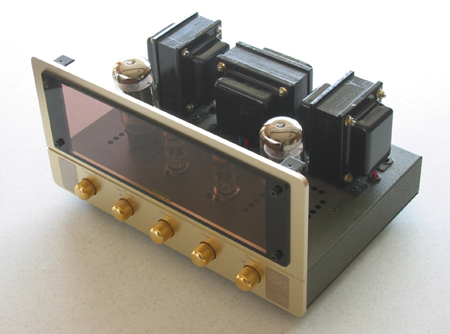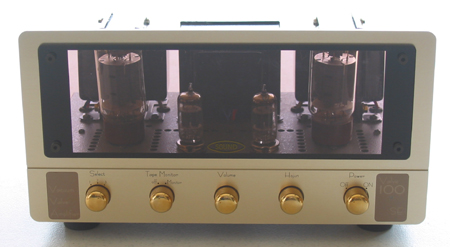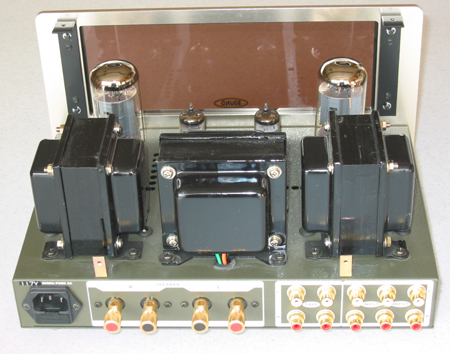You are reading the older HTML site
Positive Feedback ISSUE
18
march/april 2005
tokyo sound company
Sound SE100 integrated amplifier
as reviewed by Lester J. Mertz

|
LESTER J. MERTZ'S SYSTEM
LOUDSPEAKERS
ELECTRONICS
SOURCES
CABLES
ACCESSORIES |
Single-Ended Triode (SET) amplifiers come in many different sizes—that is, power ratings—and different prices, but this usually translates as expensive and even more expensive. Many audiophiles have tried them in their homes, and before you can say "Bob's Your Uncle," they're converts, selling off solid-state behemoths on Audiogon. Many of these recent converts have no idea what happens inside those electron tubes, and don't give a damn, but here's my executive (short) summary for those who are interested.
Triodes are electron tubes with three electrodes, the cathode, control grid, and plate. Electrons are emitted from the cathode and, after a very short trip, collected by the positive potential at the plate. The control grid, between the cathode and plate, is made from very fine wire that is wound on two side posts that usually extend the length of the cathode. The grid wires are widely spaced to allow electrons to flow to the plate unimpaired, except when a negative DC voltage is applied to that grid. The plate current (i.e., the number of electrons drawn to the plate) depends upon the plate voltage and the control grid voltage. More negative voltage on the grid decreases the plate current, while more positive voltage increases it. By applying an audio signal to the grid, we can control the plate current that also varies with this signal. Use the small grid signal to control the larger plate current and you have an amplifier!
The triode amplifier was perfected before the Great Depression, and completely dominated the market. There really wasn't anything else! Many of those circuit designs are used today, with only slight modifications. As sweet as SET sound may be (and, through the midrange, it is especially sweet), there are some inherent problems with triode amps. Capacitance between the electrodes (plate to grid, grid to cathode, and plate to cathode) is undesirable, and the main source of instability due to capacitive coupling. This leads to poor performance at higher frequencies, usually beyond the normal audio frequencies (greater than 20,000 hertz). There are some higher power (read: expensive!) tube types available, such as the 50 and 211, but the most popular triodes popular today are the 45, 2A3, and 300B.
The limited, low-single-digit power provided by most triode tubes prompted the development of other tube types. Tetrodes (four electrodes) added another element called the screen grid between the control grid and the plate. The screen grid acts as an electrostatic shield, and reduces the control-grid-to-plate capacitance considerably, allowing much higher frequency response, but there is no free lunch, and tetrodes have their own problems. Electrons are affected by the screen grid/plate current relationship, and by an effect called secondary emission, in which electrons are released from other electrodes such as the screen grid. The tetrode's plate current curve exhibits the characteristic "kink," or non-linearity, that is a source of distortion. Later engineering efforts reduced non-linearity in the plate current, or the "kink," and the resulting tubes, including the KT77 and KT88, were labeled kink-less tetrodes.
Pentodes (five electrodes) added a suppressor grid between the screen grid and the plate, to reduce the "kink" distortion and improve frequency response. Pentodes quickly replaced tetrodes in audio amplifiers. Power pentodes can operate with twice the plate efficiency of a triode, and require much less drive signal, making for simpler circuits.
Beam power tubes were the next evolution, and can be tetrodes or pentodes. The laboratory pioneering this tube type was RCA's Radiotron Division, where Otto Schade developed a power tube combining the low distortion of the triode with an efficiency exceeding that of previous pentodes. He removed the suppressor grid and replaced it with beam-confining electrodes to produce the effect he desired. This arrangement reduced the effects of the stray electrons (secondary emission) that were causing the higher harmonic distortion found in pentode tubes. Schade, following his English counterparts, hid the screen grid behind the control grid by carefully winding aligning the two under a microscope, using the exact same winding pattern for both grids. This allowed the electrons to travel to the plate without striking the screen grid—a source of distortion. The resulting beam power tube has the advantages of high power output, high efficiency, and high sensitivity. The original and most common type is the 6L6 and its descendants, the 6L6GC, 807, 5881, 7581, and others, including the 6AQ5, 6V6, and 6550. Once amplifier designers saw the advantages of this type, it took the market by storm, providing good power at about 20 watts (push/pull) from a low-cost tube.
The guitar amplifier world never left the 6L6CG types, and there are probably more than a half-million of these amplifiers in use worldwide. Leo Fender's bulletproof guitar amplifiers ("Bassman," "Pro," and "Twin") are the most famous and most copied, but newer designs such as the Mesa Boogie and others still use this fine tube. Some high-fidelity designers have also favored the 6L6 types, notably the classic McIntosh MC240 and some early Manley Labs designs, although only Air Tight, Audio Note, and a few others use this tube today. 6L6 types are still in production, with Russian and Chinese factories making tens of thousands with a variety of brand names and prices, from reasonably cheap to bordering on the ridiculous.
To learn more about tubes, I suggest a subscription to Vacuum Tube Valley (www.vacuumtube.com), or you can contact Antique Electronic Supply (800- 706-6789) for copies of manufacturers' tube manuals. They also carry classic books on tube amplifier design and just about anything you could dream of for your guitar amp.

While SETs are smooth in the midrange, the ever-increasing cost of amplifiers and triode tubes (with 300Bs going for $400 each) has pushed SETs out of the reach of the average high-end user. In reaction, some audio designers are revisiting beam power tubes as an alternative to triodes. One product that uses these is the Sound SE 100, an integrated amplifier made by the Tokyo Sound Company. This amplifier is a very simple design, with two tubes per channel—a 5751 (industrial type, low noise, high-mu twin triode, NOS from General Electric) as input and driver, and one single-ended 6L6GC (beam power type, new from Svetlana) for each channel.

This compact (12.25 inches wide x 10 inches deep x 7 inches high) amplifier looks just perfect to me. Everything about it bespeaks quality, without the excesses of some of today's over-the-top, retro-looking SETs. Three traditional-looking black transformers with end caps run straight across the rear of the gold chassis. The front panel has a smoked plexiglass window and sports five knurled control knobs of heavy, machined metal. One of the knobs selects the input from three sets of RCA input jacks located on the back of the chassis. The next turns the tape loop on and off. The center knob is a smooth volume control, right next to one marked "Hojun" (more about this later), and the last knob on the right side turns the unit on and off. A blue lamp, bright enough to be visible from the next room, indicates that the amp is running. No manual or other instructions came with the amp. There are screw holes that seem to be for a tube cage, but none was provided.

Connections were intuitive and straightforward. The speaker posts, marked 8 ohm, are unique, solid, and large, allowing for large-gauge wire, spades or banana connectors. There is an IEC power connector, and the amplifier responded to premium power cords nicely, with various cords showing their sonic differences. (Speaking of power cords, it seems to me that they make more of a difference than most other upgrades, including interconnects, yet interconnects are usually the first purchase for the beginning audiophiles upgrading their systems. Then again, because of their high input impedances, tube amps seem much less susceptible to interconnect changes.)
Now for the sound! This amp has the stuff that audio dreams are made of. It is sweet, relaxing, and musically involving, never fatiguing or harsh. This surprising amplifier can drive most audiophile speakers to modest listening levels in reasonably sized rooms. The music of choice will be light classical, such as trios and quartets, and small jazz ensembles. If you want to listen to heavy metal and loud rock, this is definitely not your amplifier. It only puts out 7 or 8 watts, unless you are wiling to live with ever-increasing distortion when pushing the limits.
Speaker selection is often limited when using SET amplifiers, and this is something to think about if you are considering making the switch. Excellent sounding, reasonably priced, high-sensitivity speakers are not plentiful. There are a few standouts, but most lack bass quality. If you fall in love with the single-ended sound, the amplifier may end up being the cheapest part of the equation. Dealers that sell these amplifiers often use very efficient and expensive loudspeakers to reel you in. Are you ready to make a commitment to exotic speakers? Be prepared to spend many times more for the speakers than you will for your first SET amplifier.
I tried three different speakers—a low-sensitivity transmission line (<84dB), a vented type of moderate sensitivity (88dB), and a modestly sized but very sensitive speaker (Fostex) in a folded horn (95dB). The last, the Madisound BK-16 folded horn, is suitable for orchestral works in mid-sized rooms. The Sound SE 100 behaved well with the Madisound, even at fairly loud levels, and the Madisound kit is a great starting point for a single-ended system. Some weight can be given to the sound with the Hojun control knob, which changes both the level and quality of the bass. While your tastes may be different than mine, I preferred the more counter-clockwise settings, which produced tighter bass from all of the speakers I tried. Adjusting the control to the full clockwise position gave me the soft, under-damped bass sound made by the tube amplifiers of more than forty years ago.
I played the SE 100 for extended periods while I was breaking in the new tubes, and there was never any spitting or other misbehavior, either at startup or after 12- to 15-hour listening sessions. I believe that Tokyo Sound has done its homework, and has produced a reliable and consistent performer.
I frequently use piano recordings to separate the great systems from the pretenders. With the SE 100, piano sounded just beautiful. Everything, and I mean everything, was heard with this amplifier—every pedal movement, every hammer on the string—and it brought the instrument right into the room with me. Everything was also in proper perspective, with nothing to beat me up or wear me out. The piano is a very difficult instrument to reproduce properly because of its tonal range and dynamics. It is also difficult to record, but I give thanks here to Mapleshade Record's recording of Larry Willis, Solo Spirit. This is an exquisite recording, with sparse, gentle notes and great sustain from the piano. The instrument sounded loud, lifelike, and involving through the SE 100 and the Madisound/Fostex folded horns.
Another test recording I used was Silk Road Journeys: When Strangers Meet, by Yo-Yo Ma and the Silk Road Ensemble. Each cut has sonic surprises, but the ninth, "Franghiz Al-Zadeh: Habil Sayagy (In Habil's Style) for Violoncello and Prepared Piano," is my favorite. You'll be awed by the sounds created by the prepared piano. The first time I heard this piece, I thought there was some sort of exotic drum in the background, but the resolution of the Sound SE 100 let me discern the piano effects being used. Of course, Yo-Yo Ma's cello is beautiful on this and every other cut of this intriguing album. I had lots of fun listening to this one! Any of the First Impression Music recordings are of absolute reference quality, and one of my all-time favorites is Jacintha's Here's to Ben, her tribute to Ben Webster. Any of the cuts is awe-inspiring, but "Danny Boy" was just a revelation on the Sound SE 100.
The Sound SE 100 is priced to be competitive with Far East imports (read China), and is a well-made amplifier with enough power to drive relatively low-sensitivity speakers. Japanese manufacturers are known for using the finest transformers, and though the end caps on the SE 100 are not marked Tamura or Tango, it produced superior sound quality. Retubing this little baby won't break the bank, and there are tons of tubes to roll through the outputs while you seek that special sound. It might be worth investing in a pair of RCA black plates if you can find (and afford) them. Of the single-ended integrated amplifiers that I've heard in this price range, the SE 100 definitely ranks above the pack, and is a great way to start on the single-ended path. I'd like to thank Fred Kat, of Katli Audio in Chino Hills, California for the opportunity to have an extended listen to this wonderful single-ended, beam-power tube amplifier. Les Mertz
SE 100 integrated
Retail: $1500
web address: www.katli.com
